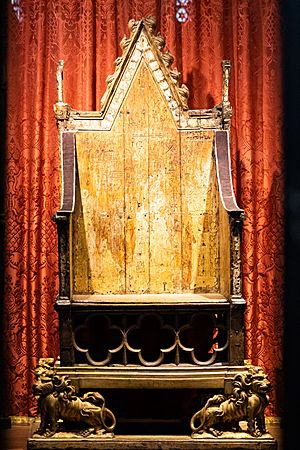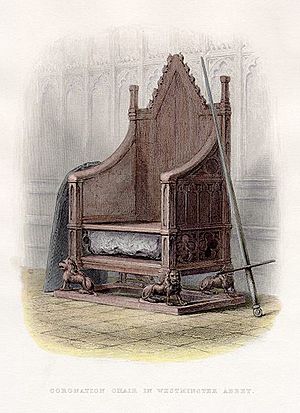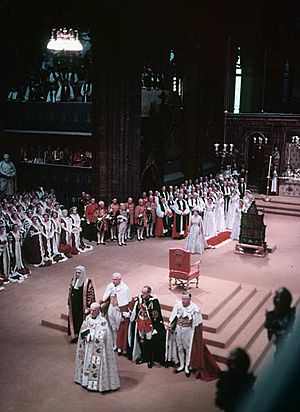Coronation Chair facts for kids

The Coronation Chair, also known as St Edward's Chair or King Edward's Chair, is an ancient wooden chair on which British monarchs sit when they are invested with regalia and crowned at their coronations. It was commissioned in 1296 by King Edward I to contain the coronation stone of Scotland—known as the Stone of Destiny—which had been captured from the Scots. The chair was named after Edward the Confessor and was kept in his shrine at Westminster Abbey.
History
In 1296, the English king Edward I seized a block of sandstone from Scone Abbey in Perthshire called the Stone of Scone, or the Stone of Destiny. This stone had been used by Scottish kings for centuries to sit upon when they were crowned. Edward brought the Stone to England and commissioned the Coronation Chair to hold it. The high-backed, Gothic-style armchair was carved from oak at some point between the summer of 1297 and March 1300 by the carpenter Walter of Durham. At first, the king ordered the chair to be made of bronze, but he changed his mind and decided it should be made of timber. It was originally covered in gilding and coloured glass, much of which has now been lost. The chair is the oldest dated piece of English furniture made by a known artist. Although it was not originally intended to be a coronation chair, it began to be associated with coronations of English monarchs at some point in the 14th century, and the first coronation where it was definitely used was that of Henry IV in 1399. Monarchs used to sit on the Stone of Scone itself until a wooden platform was added to the chair in the 17th century.
When William III and Mary II became joint monarchs in 1689, they required two coronation chairs for the ceremony. William III used the original 13th-century chair, while a second chair was made for Mary II, which still resides in the abbey's collections.
Gilded lions added in the 16th century form the legs to the chair; they were all replaced in 1727. One of the four lions was given a new head for the coronation of George IV in 1821. The chair itself was originally gilded, painted and inlaid with glass mosaics, traces of which are visible upon inspection of the chair, especially on the back where outlines of foliage, birds and animals survive. A lost image of a king, maybe Edward the Confessor or Edward I, with his feet resting on a lion was also painted on the back. Today, its appearance is of aged and brittle wood.
In the 18th century, tourists could sit on the chair for a small payment to one of the vergers. Early tourists and choirboys of the abbey carved their initials and other graffiti into the chair, and the corner posts have been acutely damaged by souvenir hunters. Nails have often been driven into the wood to attach fabric for coronations, and in preparation for Queen Victoria's Golden Jubilee, the chair was covered with a coating of brown paint. .....
At 5:40 pm on 11 June 1914, the chair was the object of a bomb attack thought to have been organised by the Suffragettes. A corner of the chair was broken off in the explosion. Although it was strong enough to shake the abbey walls and loud enough to be heard from inside the Houses of Parliament, none of the 70 people in the abbey at the time was injured, and the Coronation Chair was faithfully restored.
Over the eight centuries of its existence, the chair has only been removed from Westminster Abbey twice. The first time was for the ceremony in Westminster Hall when Oliver Cromwell was inducted as Lord Protector of the Commonwealth of England. The second was during the Second World War when, concerned about the risk of it being damaged or destroyed by German air raids, it was moved out of London. On 24 August 1939, the Stone of Scone was moved out of the way and the chair was loaded on a truck and, with two detectives accompanying the driver, it was driven to Gloucester Cathedral where the Dean and the Cathedral Architect signed for its receipt. The next day, five carpenters arrived to shore up the roof of a vaulted recess in the cathedral's crypt with timber supports. Once they had finished their work, the chair was moved into the recess. As it also provided the best protected location, the cathedral's 13th-century bog-oak effigy of Robert Curthose was placed on the chair. Sandbags were then used to seal off the recess. The chair remained there for the duration of the war. Meanwhile the chair used for the coronation of Mary II was relocated from Westminster Abbey to Winchester Cathedral for safekeeping.
On Christmas Day 1950, Scottish nationalists broke into Westminster Abbey and stole the Stone of Scone, damaging the stone. It was recovered in time for Queen Elizabeth II's coronation in 1953. In 1996, the stone was returned to Scotland, where it is kept at Edinburgh Castle on the proviso that it be returned to England for use at coronations.
The Coronation Chair is highly protected, and leaves its secure location—behind glass on a plinth in St George's Chapel in the nave—only when it is carried into the theatre of coronation near the High Altar of the abbey. Between 2010 and 2012, the chair was cleaned and restored by a team of experts in full view of the public at the abbey. In early 2023, a further programme of restoration and conservation was undertaken in preparation for the coronation of Charles III and Camilla.
Other chairs used at the coronation
Other chairs are also used throughout the coronation ceremony. Chairs of Estate for the sovereign and consort are placed on the south side of the sanctuary, and these are used during the first part of the liturgy, prior to the sovereign's anointing and crowning with St Edward's Crown. Then, for a part of the service called the enthronement, and for the homage which follows it, the monarch is placed not in the Coronation Chair, but in a throne on a dais in the middle of the transept. On occasions when the wife of a king—a queen consort—is crowned, a similar throne is provided for her so that she can be seated next to the king but at a lower level.
Unlike the Coronation Chair, these other chairs and thrones tend to be made new for each coronation. Afterwards, they have often been placed in the Throne Rooms of royal palaces. The Chair of Estate from the 1953 coronation can be found in the Throne Room of Buckingham Palace, along with those of George VI and his consort Queen Elizabeth. The 1953 throne is kept in the Garter Throne Room of Windsor Castle; the thrones of King Edward VII and Queen Alexandra are in the Ballroom at Buckingham Palace. Those of George V and Queen Mary may be seen in the Throne Room at the Palace of Holyroodhouse in Edinburgh.
See also
- Chair of St Peter
- List of chairs
- Westminster Stone theory
$



